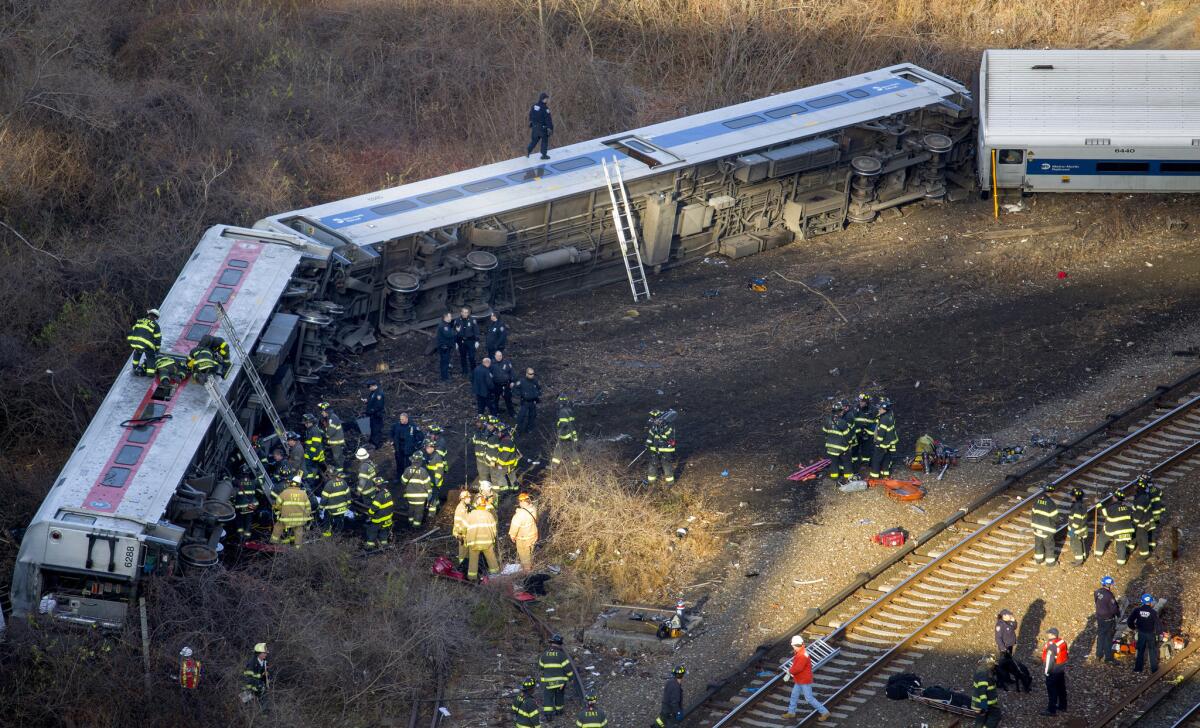Feds order tougher safety measures after New York train derailment

Responding to the deadly crash of a commuter train that was speeding through a difficult turn in the Bronx, the Federal Railroad Administration on Friday ordered the rail line to modify its signal system to ensure that speed limits are obeyed.
The move comes as New York Gov. Andrew Cuomo ordered transit officials to adopt stricter safeguards, including accelerating efforts to install technology that can automatically bring a train to a stop if it is exceeding the speed limit.
On Sunday, a Manhattan-bound Metro-North train was traveling 82 mph when it entered a curve near the Spuyten Duyvil station in the Bronx, according to the National Safety Transportation Board. The speed limit for the curve was 30 miles per hour. The train derailed, killing four passengers and injuring more than 60 people.
William Rockefeller, the engineer, has been suspended without pay. His lawyer and the head of his union have said Rockefeller said he went into a daze as he entered the turn, then engaged the brakes to cut speed.
In its emergency order, the Federal Railroad Administration required Metro-North to prepare by Dec. 10 a list of main track locations where there is a reduction in the speed limit of more than 20 miles per hour.
“Metro-North is ordered to identify appropriate modifications to its existing automatic train control system or other signal systems to enable adequate advance warning of and adherence to such speed restrictions. These modifications will help prevent another over-the-speed-limit event if a locomotive engineer fails to take actions to appropriately slow or stop a passenger train,” the agency said
As an interim measure, Metro-North was ordered to operate trains with two qualified crew members in the controlling locomotive cab or passenger car control compartment at the locations where speed limits change by 20 miles per hour until the signal work is completed.
“Safety is our highest priority, and we must do everything we can to learn from this tragic crash and help prevent future derailments,” U.S. Transportation Secretary Anthony Foxx said. “While we assist the National Transportation Safety Board in carrying out its investigation, this emergency order will help ensure that other Metro-North trains travel at appropriate, safe speeds.”
The MTA, which runs Metro-North and other transportation lines in New York, said it would abide by the federal order.
“The MTA is working closely with the Federal Railroad Administration to review our policies and procedures in light of Sunday’s tragic derailment, and we will of course comply with whatever requirements the FRA directs us to follow,” spokesman Adam Lisberg said in an email to the Los Angeles Times. “We are examining many other possible steps we can take to improve the safety of our railroad operations, and will continue making every effort to enhance customer and employee safety.”
Cuomo has raised the issue of the train’s speed since Sunday’s crash.
“While the National Transportation Safety Board’s investigation of the recent Metro-North Railroad derailment remains ongoing, reports have now made clear that the actions of engineer William Rockefeller were the initiating cause of this tragic accident,” Cuomo said in a statement Friday.”The train’s speed, which Mr. Rockefeller controlled, was over 50 mph above the maximum allowed speed at the time of derailment.”
Specifically, Cuomo directed the MTA to expedite speed controls for areas vulnerable to crashes on the Metro-North and Long Island Rail Road commuter systems. The governor also asked the agency to step up efforts to bring so-called positive train control technology to the commuter systems. The systems are designed to use computers to monitor position and speed and to automatically engage braking and safety measures if a potential collision is detected.
Sen. Dianne Feinstein (D-Calif.) said on Thursday that such technology probably would have prevented the derailment in the Bronx, regardless of whether mechanical failure or human error caused it. On Friday, Rep. Grace Napolitano (D-Los Angeles) added her voice to calls to install the technology by 2015, as currently required by law.
The railroad industry, however, has been lobbying lawmakers to extend the deadline to 2020, citing an estimated cost of at least $10 billion and the complexity of implementing the system on about 60,000 miles of track nationwide.
ALSO:
Mid-South braces for winter weather as storm moves East
New Mexico cop on leave after firing at minivan filled with kids
Pot burger? This fast food item from Wendy’s had a pungent surprise inside
More to Read
Sign up for Essential California
The most important California stories and recommendations in your inbox every morning.
You may occasionally receive promotional content from the Los Angeles Times.











